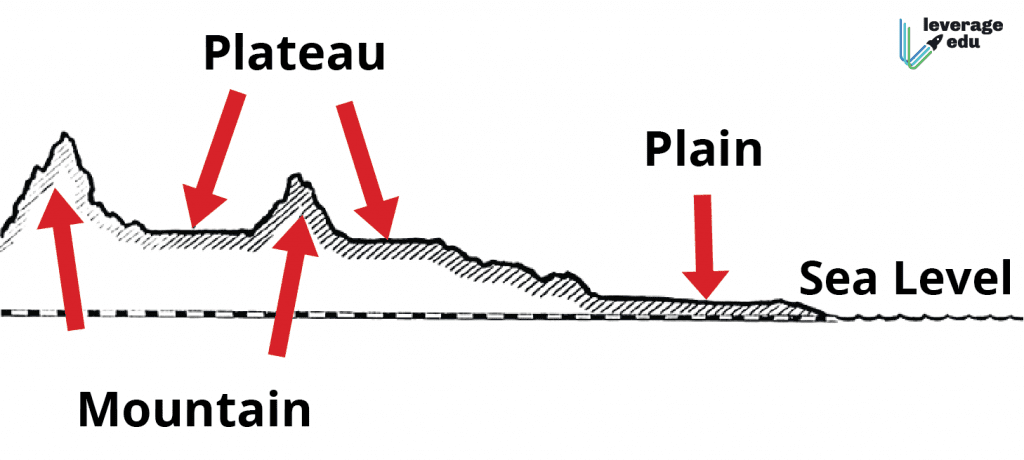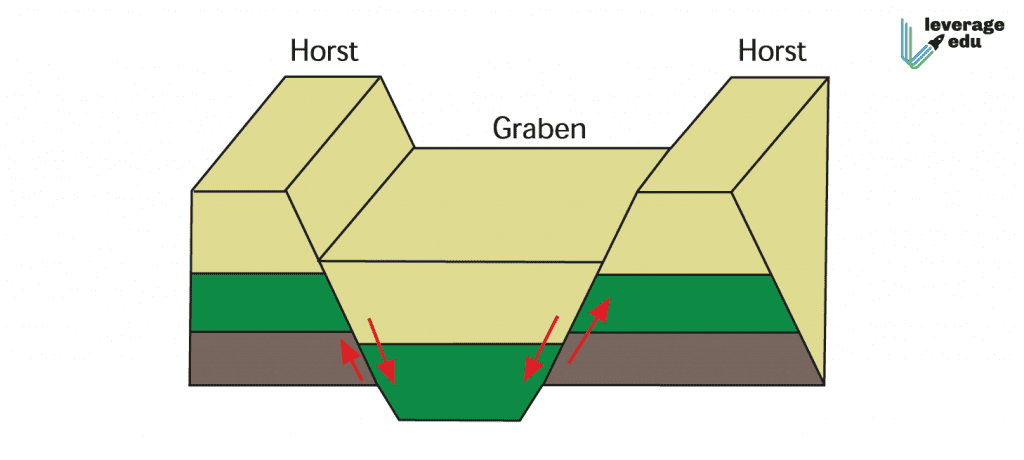Major Landforms of the Earth: India is a culturally and geographically diverse country. From the world’s second-highest peak Kanchanjunga (K2), Siachen Glaciers, the Thar Desert to the rainiest city of Cherrapunji, India has many impeccable geographical wonders to offer. It is also blessed with beautiful landscapes and landforms spread across the country. Curious to explore the major landforms of the earth? This blog will take you on an informational ride to discover the different landforms of our planet. This interesting topic is not only a part of the scholastic syllabus of class 6th but is an essential mention in the syllabus of many competitive exams like UPSC Exams etc. So, let’s walk you through the major landforms of the earth Class 6.
This Blog Includes:
What are Landforms?
Landforms are the physical features on the outer layer of the earth, i.e. its surface. The earth’s landforms take their actual shape naturally through various processes such as weathering, sinking, soil erosion, elevation, water etc. The major landforms of the earth are Mountains, Plateau and Plains.
The process of formation of these surfaces didn’t happen overnight and took millions of years to take the shape they have now as these major landforms of the earth are created through different geological processes. Under these natural phenomena, there are a variety of internal and external activities which take place such as Rain, Wind, Volcanic Eruptions etc which contribute to the formation of the landforms.
Recommended Read: Geography Syllabus
Formation of Landforms
There are two processes that lead to the formation of different landforms, namely:
- External Processes: this process relates to the continuous wearing down and rebuilding of the earth’s surface.
- Internal Process: this process deals with the movement of the earth’s surface and results in a portion of the earth’s surface getting either elevated or sunk.
Also Read: NCERT Class 6 Geography Chapter 6 – Our Country India
W.E.D
- Weathering: it is the process by which rocks are broken down that can create sediments. There are 2 forces due to which weathering can occur i.e., chemical weathering and mechanical weathering. Weathering agents can be water, ice, wind, animals, growing plants etc.
- Erosion: Erosion is the process by which natural forces acting on a weathered rock and soil move the weathered rock and soil from one place to another. It can be caused due to gravity, running water, glaciers, wind etc. The materials that are being moved due to erosion are called sediments.
- Deposition: Deposition is the process which occurs when agents like wind or water of the erosion lay down the sediments. Hence, it changes the shape of the land. An example of deposition can be the formation of an island or sand dunes.

Also Read: NCERT Class 6 Geography Chapter 5 – Major Domains of the Earth
Major Landforms of the Earth Class 6
Considering the elevation and slopes, the major landforms of the earth can be bifurcated into three categories, namely Mountains, Plateaus and Plains. Mentioned below is the detailed analysis of each of these.

Also Read: Class 9 Geography Notes
Mountains
A preferred holiday destination of many, Mountains refers to those landmasses which are steeper and higher than a hill. Generally, mountains are above the height of 2,000 ft. The sloppy landmasses below the given height are often categorized as hills. As we go higher up the mountains, the atmospheric pressure tends to increase making the temperature drop down. That’s why mountains have a colder temperature than other regions.
Due to lower temperatures, mountains often have snow on them, making it difficult for lives to prosper in such extreme conditions. Some mountains at great heights even have glaciers on them. The beautiful mountains in a line together are called range. Because of harsh weather conditions, these landforms of the Earth are naturally formed and abode to undiscovered flora and fauna. Here are the popular types of mountains:
Also Read: BA Geography- Syllabus, Universities, Jobs, Books
Fold Mountains

Whenever the collision of tectonic plates takes place and the edges of these plates ‘fold’, Fold Mountains are created.
Also Read: NCERT Class 6 Geography Chapter 4 – Maps
Block Mountains

Whenever large areas break and get displaced vertically, it results in the formation of Block Mountains.
Also Read: Geography Syllabus for 9th, 10th and UPSC Preparation
Volcanic Mountains

Volcanic Mountains are formed whenever the Magna rises above the earth’s crust.
Plateaus
Plateaus can be determined as the flat land which stands high above the surroundings. In other words, Plateaus are simply elevated flatlands. The height of a plateau can vary by 100 meters or may remain the same for a thousand meters. One of the major landforms of the earth, Plateaus are formed due to the lava inside the earth.
The most common plateau in India is the Deccan Plateau. Lying in the Chotanagpur region, the Deccan Plateau is a famous reserve for a variety of minerals and ores. Apart from this, the famous plateau regions on the earth are the Tibetan Plateau, African Plateau etc. The Africa Plateau is a hotspot of diamond mining whereas the Tibetan Plateau is the highest plateau in the world.
Plains
The long stretches of flat land are called Plains. Plains are regarded as highly fertile regions as they are the ideal geographical location for various human and agricultural activities including farming, poultry, etc.
Usually, Plains are formed due to rivers and their tributaries. In our country, the Indo-Gangetic Plain is the most densely populated area.
Glacier
A glacier is nothing but a huge mass or chunk of ice that moves slowly over land. They are often called ‘rivers of ice’ too. They are found in some of the very high mountains or places where the temperature is really low which allows the river to freeze. Glaciers are of two types:
- Alpine glaciers: these glaciers are formed at the mountainsides and move downward through the valleys. Examples can be Gorner Glacier in Switzerland.
- Ice sheets: on the contrary to the alpine glaciers, the ice sheets are not restricted or limited to the mountain areas. They form huge and broad domes that can spread out from their centres in all directions. The largest ice sheet which covers most of the areas of Antarctica and the islands of Greenland are known as continental glaciers.
Also Read: CBSE Notes Class 7 Geography
Major Landforms of the Earth Class 6 PPT
Major Landforms of the Earth Class 6 PDF
Check out the NCERT Major Landforms of the Earth Class 6 PDF Here!
Major Landforms of the Earth Class 6 MCQs
1. Which among these is the mountain range of South America?
A. The Himalayas
B. The Alps
C. The Andes
D. The Rockies
2. Mt. Kilimanjaro is in which continent?
A. Asia
B. Africa
C. South America
D. North America
3. Which sport is not popular in the mountains?
A. Paragliding
B. Skiing
C. Hang gliding
D. Football
4. The Hundru falls is in?
A. Chhotanagpur
B. Calcutta
C. Ranchi
D. Chhattisgarh
5. The world’s highest plateau is the
A. Deccan plateau
B. Tibet plateau
C. Chhotanagpur plateau
D. East African plateau
6. The wearing away of the earth’s surface is called
A. Mountains
B. Plateau
C. Erosion
D. Deposition
7. In some mountains there are permanently frozen rivers of ice known as
A. River Valley
B. glaciers
C. Plateaus
D. None of the above
8. Mountains may be arranged in a line known as?
A. Horsts
B. Range
C. Glaciers
D. All of these
9. Tibet is a
A. Plateau
B. Mountain Range
C. Both (a) and (b)
D. None of the above
10. Which area is the most useful for human habitation?
A. Plain
B. Mountain
C. River
D. Glacier
Answers
- C
- B
- D
- A
- B
- C
- B
- B
- A
- A
Also Read: CBSE Notes Class 6 Geography
Major Landforms of the Earth Class 6 Questions and Answers
The major landforms are:
Mountains
Plateaus
Plains
There are 3 different types of Mountains:
Fold Mountains
Block Mountains
Volcanic Mountains
Mountains are beneficial to man in a variety of ways. For example:
Mountains retain water.
Mountain water is also used for irrigation and hydroelectric power generation.
Crop cultivation is appropriate in the river valleys and terraces.
Mountains are home to a diverse range of flora and wildlife.
In the mountains, paragliding, hang gliding, river rafting, and skiing are all popular activities.
Mountain erosion occurs when rivers run through mountain slopes. The eroded material is carried by the flowing river, and deposit materials such as silt, clay, and stones are gathered in the valleys. Plains are formed as a result of this process.
Because of the plains’ fertility, river plains are densely populated. As a result, building a transportation network is considerably easier.
Also Read: CBSE Geography Class 9 Drainage Notes (Free PDF)
FAQs
The mountains, plains and plateaus are some of the major landforms of the earth.
The major landforms of India include the Himalayas and the western and the eastern ghats.
India is a peninsular region which means being surrounded by water on the three sides.
We hope that through this blog you are familiarised with the major landforms of the earth. Unsure about which stream to pursue after the 10th? Reach out to our Leverage Edu experts and we will assist you in selecting the right stream which aligns with your preferences and interests.

 One app for all your study abroad needs
One app for all your study abroad needs





















 45,000+ students realised their study abroad dream with us. Take the first step today.
45,000+ students realised their study abroad dream with us. Take the first step today.

